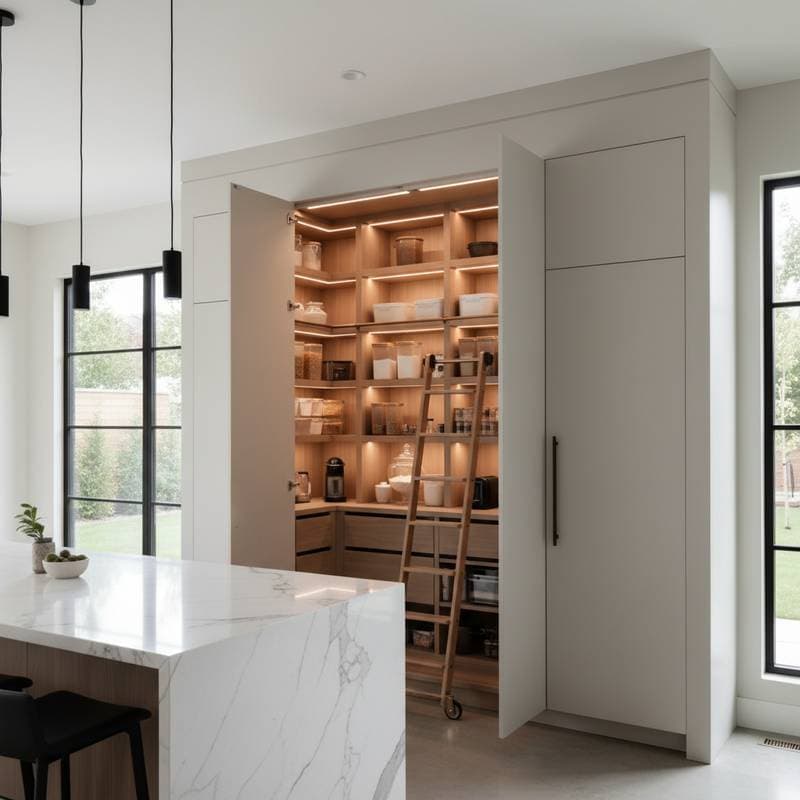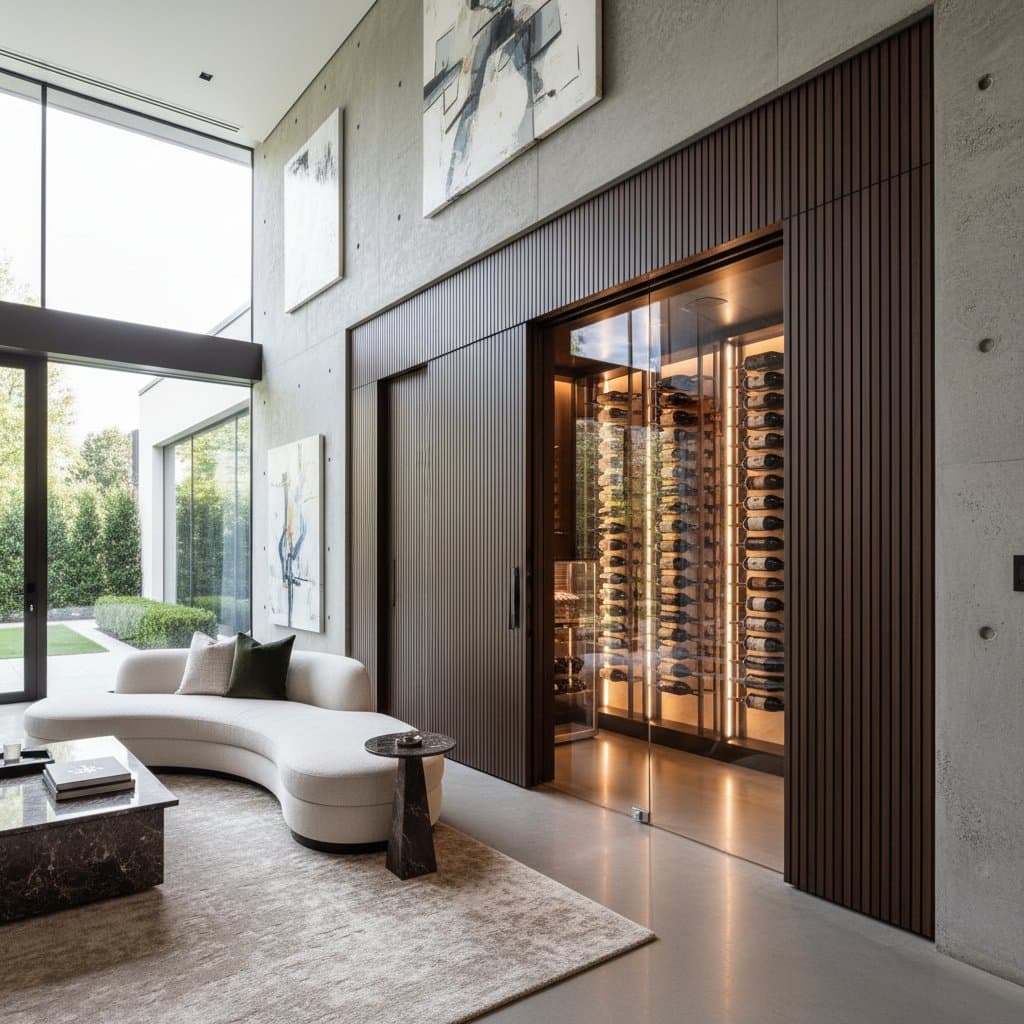Hidden Wine Cellars: 15% Home Value Boost in 2025
Hidden wine cellars capture the interest of homeowners seeking functional upgrades that enhance resale value. These concealed storage areas integrate design elements, security features, and precise climate control to form a premium addition to any property. Individuals who host gatherings, maintain collections, or desire subtle luxury find that such installations elevate daily experiences while increasing market appeal.
Data from recent high-end property sales indicates that residences featuring thoughtfully constructed wine storage can achieve a 10 to 15 percent increase in resale value. This uplift hinges on factors such as craftsmanship, seamless incorporation into the home, and strategic placement. Homeowners with underutilized basement areas, extra rooms, or expansive kitchen pantries stand to benefit most from this transformation.
Pros and Cons
Pros
- Increases property value by up to 15 percent through superior design execution.
- Maintains optimal wine conditions via consistent temperature and humidity regulation.
- Enhances luxury perception, attracting prospective buyers and visitors alike.
- Utilizes overlooked spaces like basements, areas under staircases, or recessed wall sections.
- Bolsters security by concealing valuable collections from plain view.
Cons
- Involves substantial initial expenses relative to standard visible shelving solutions.
- Demands ongoing energy for climate control systems throughout the year.
- Often necessitates modifications to the building structure in established homes.
- Presents challenges for independent construction due to requirements for refrigeration and insulation.
- Reduces available living space in compact residences where square footage proves essential.
DIY vs Professional Installation
Constructing a hidden wine cellar demands expertise in cooling mechanisms, insulation techniques, and moisture management.
DIY Difficulty Level: High. Tasks include achieving exact temperature settings, installing vapor barriers, and ensuring airtight door seals.
Estimated Timeline: Three to six weeks, varying by existing structure and desired finishing touches.
Essential Tools: Power saws for precise cuts, insulation panels, vapor barrier sheets, dedicated climate control units, and digital humidity gauges.
Primary Risks: Inadequate insulation or faulty seals may result in condensation buildup, mold growth, or fluctuating conditions that compromise wine integrity.
Consider Professional Assistance When:
- The storage capacity exceeds 200 bottles.
- Resale occurs within the next few years, requiring verified appraisal enhancements.
- Features incorporate glass enclosures, mechanical lifts, or disguised entryways.
- The property's foundation or basement demands reinforcement for stability.
Engaging a certified wine cellar specialist guarantees adherence to building codes, effective ventilation, and humidity maintenance between 55 and 70 percent.
Maintenance and Longevity
A properly constructed hidden wine cellar endures for decades under diligent upkeep. Cooling components generally function for eight to twelve years prior to needing replacement.
Recommended Maintenance Routine:
- Monthly Inspections: Monitor humidity and temperature levels using a digital device.
- Quarterly Tasks: Remove debris from cooling unit filters and examine door seals for wear.
- Annual Servicing: Conduct full cooling system tune-ups and scan for signs of condensation or leaks.
For installations with automated features or integrated lighting, establish alerts to verify sensor functionality and backup power sources. Professional setups often carry warranties, typically five years on equipment and one year on labor. Verify all terms prior to finalizing the project.
Regional Considerations
Climate Influences:
In regions with elevated warmth or humidity, opt for robust cooling setups and comprehensive vapor sealing. Coastal environments call for hardware and racking materials resistant to corrosion.
Building Codes and Permits:
Certain municipalities mandate approvals for electrical or mechanical installations tied to cooling apparatus. Alterations beneath staircases or to flooring may prompt required inspections. Review applicable local regulations early in the planning phase.
Labor Cost Variations:
Hourly rates for skilled labor span $50 to $150, influenced by local market dynamics. Urban centers frequently incur elevated charges for design consultations and engineering assessments.
Soil and Foundation Impacts:
Properties with basements susceptible to dampness benefit from added sump pumps or enhanced drainage solutions before cellar development. Elevated groundwater levels increase expenses yet safeguard enduring performance and value.
Safety Protocols
Wine cellars incorporate various utilities that require careful management to prevent hazards.
- Electrical Standards: Connect cooling units and illumination to grounded outlets equipped with ground fault circuit interrupter protection.
- Moisture Control: Implement vapor barriers and waterproof linings to avert mold proliferation or structural deterioration from seal failures.
- Structural Integrity: Perform load-bearing assessments for floor- or stair-integrated designs prior to any incisions or reinforcements.
- Glass and Mechanical Elements: Select tempered glass for enclosures and approved mechanisms for retractable trapdoors.
- Regulatory Compliance: Consult local authorities on electrical and structural modifications. Unauthorized work could impact insurance coverage or future sales.
Frequently Asked Questions
What minimum space is required for a hidden wine cellar?
Compact units under staircases or within walls begin at 20 square feet. Comprehensive basement adaptations typically demand 80 to 150 square feet. Allocate at least two square feet for every 20 bottles to facilitate easy retrieval.
Is a basement necessary for construction?
No. Homeowners frequently install discreet cellars behind cabinetry, beneath kitchen surfaces, or inside oversized pantries. Insulation and cooling remain critical irrespective of the site.
What temperature range is optimal?
Maintain 55 to 58 degrees Fahrenheit with 60 to 70 percent relative humidity. Consistent conditions outweigh minor deviations in precision.
Do these cellars require ventilation?
Yes. Cooling equipment necessitates outlets for expelling heated air. Systems with ducting can direct exhaust to nearby interiors or exterior spaces.
What is the typical installation duration?
Professional projects span three to eight weeks, contingent on design intricacy, permit processing, and supply chain factors.
Steps to Plan Your Installation
A hidden wine cellar merges skilled workmanship, advanced technology, and thoughtful aesthetics into a understated enhancement that elevates lifestyle and asset worth. Select between a modest under-stair configuration or an extensive basement overhaul, emphasizing preparation throughout.
First, determine storage needs based on collection size. Assess the site's structural soundness and choose a dependable cooling solution ahead of aesthetic decisions. Prioritize operational efficiency over ornamental details.
To proceed, engage a licensed contractor experienced in wine cellars. Solicit comprehensive bids covering design, build, and equipment integration. Evaluate no fewer than three options to ensure alignment with budget and expectations.
Ultimately, this installation transcends mere storage. It nurtures your collection, enriches routine enjoyment, and positions your home for significant market gains through discerning double-digit appreciation.











